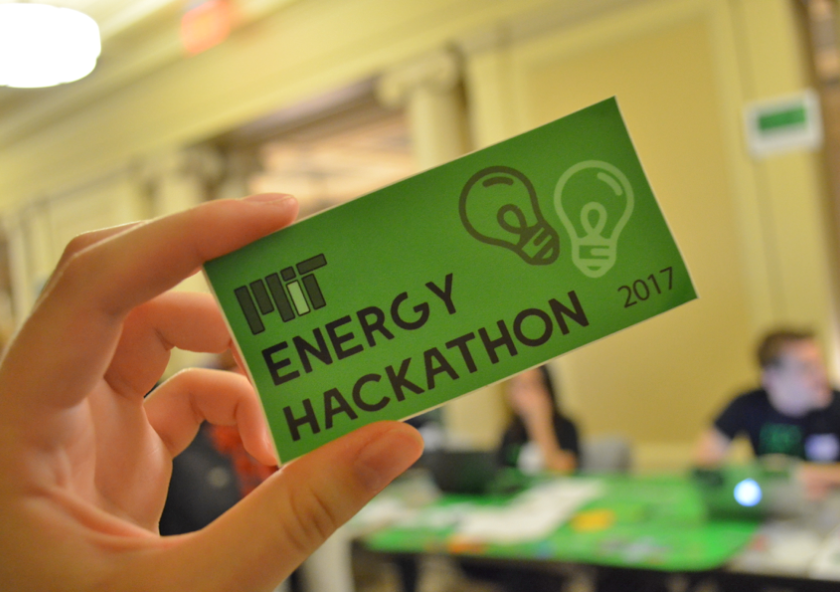
A year of many firsts for the MIT Energy Hackathon

Over the first weekend of November, the lobby of MIT’s Vannevar Bush Building served as the site for many introductions, brainstorming sessions, and, ultimately, innovation. Participants from all over the world traveled to Cambridge to compete in the three-day annual MIT Energy Hackathon.
In previous years the competition, which challenges competitors to address real-life issues in the worldwide energy sector, drew in 20 or so teams. This year, the number of teams effectively doubled, and a group of approximately 50 high school students from China competed as well.
The sharp and global rise in participants reflects well on the efforts of the organization that planned the event: the MIT Energy Club. The student group aims to generate conversations about the world’s current energy challenges and holds various events and meetings throughout the academic year.
“This is quite a unique type of hackathon,” said Akshat Agarwal, co-director of the hackathon and graduate student in the Department of Aeronautics and Astronautics. “In most types of hackathons, you sort of just turn up and come up with an idea. In the energy industry, it’s way too complicated to do that.”
In an effort to ease the complication and to facilitate direct involvement in energy issues, the organizers solicited problem statements from nine companies. The companies which submitted problem statements included McKinsey and Company, Pioneer Natural Resources, The Energy Authority, Shell, Purpose Energy, General Motors, Cimetrics, Customer First Renewables, and the NESEA Building Energy Conference.
After the event’s opening remarks in Huntington Hall, the problem statements were presented in succession by company representatives to an eager crowd of 300-plus. Following each presentation, a brief chatter could be heard amongst the crowd, indicating a competitive contemplation.
After all the challenges were presented, participants headed down to Lobby 13 where they ate dinner, met other participants, and organized into teams. Company representatives stood by labeled easels and answered questions about their challenges.
“Most people come in without a team,” said Sarah Curtis, co-director of the event and junior studying chemical engineering. “If they congregate near the challenges they’re interested in, then they’ll find likeminded individuals they can connect with.”
Though the general design of the hackathon has remained similar over the years, this year’s event organizers — known as the Hackathon Team — incorporated new elements. Each new element was designed to enhance the hackathon experience for competitors and company representatives.
The first element: an algorithm to assign challenges to teams. After dinner and discussion, teams used an online portal to submit a list of the top four challenges they wished to address.
The new algorithm used the submitted data to make sure that no challenges were over- or underrepresented while also ensuring that as many teams as possible were assigned their first or second choice.
The algorithm “optimizes generally for happiness within those constraints,” said Curtis.
After the algorithm assigned challenges to teams the next morning, competitors set off to work all over the MIT campus. Most, however, stayed near Lobby 13. The Hackathon Team stayed in the lobby from 8 a.m. to 11 p.m., fielding questions from participants and company representatives.
Some company representatives spoke with students as they worked. “It’s really exciting for me,” said Robert Trinnear, a representative from The Energy Authority. “When you see these young people on a Friday night ... working away on these problems and getting this fresh perspective. It’s exciting for the future of this country.”
On the final day of the event, teams displayed their proposed strategies on e-poster boards — another first for the event. Teams gave two-minute presentations to 18 judges drawn in from the energy industry and MIT community.
Judges asked questions following the rapid presentations, and entered their evaluations onto tablets. The tabulated results were used to select nine final teams, which each presented their proposals to the entire audience of judges and participants in Huntington Hall.
The final nine teams learned of their selection live — only seconds before they gave their presentations to the audience. Similar to the setup of the e-poster session, teams gave two-minute presentations and answered questions from judges.
Each particular problem statement had its own winner, and the Hackathon also gave out 1st, 2nd, and 3rd place prizes to overall competition winners.
The team that won 1st place overall was the Electrons, which included college students from MIT, Mount Holyoke College, and Northeastern University, as well as a high school student from China. The team was awarded a $2,000 cash prize.
After the success of this year’s event, The Hackathon Team has high hopes for those who participated.
“I really hope that companies and students stay in touch,” said Agarwal. “The main success of the event is if they stay in touch.”
Agarwal added that he is excited for future years of the event.
“I might participate next year instead!” he said.

